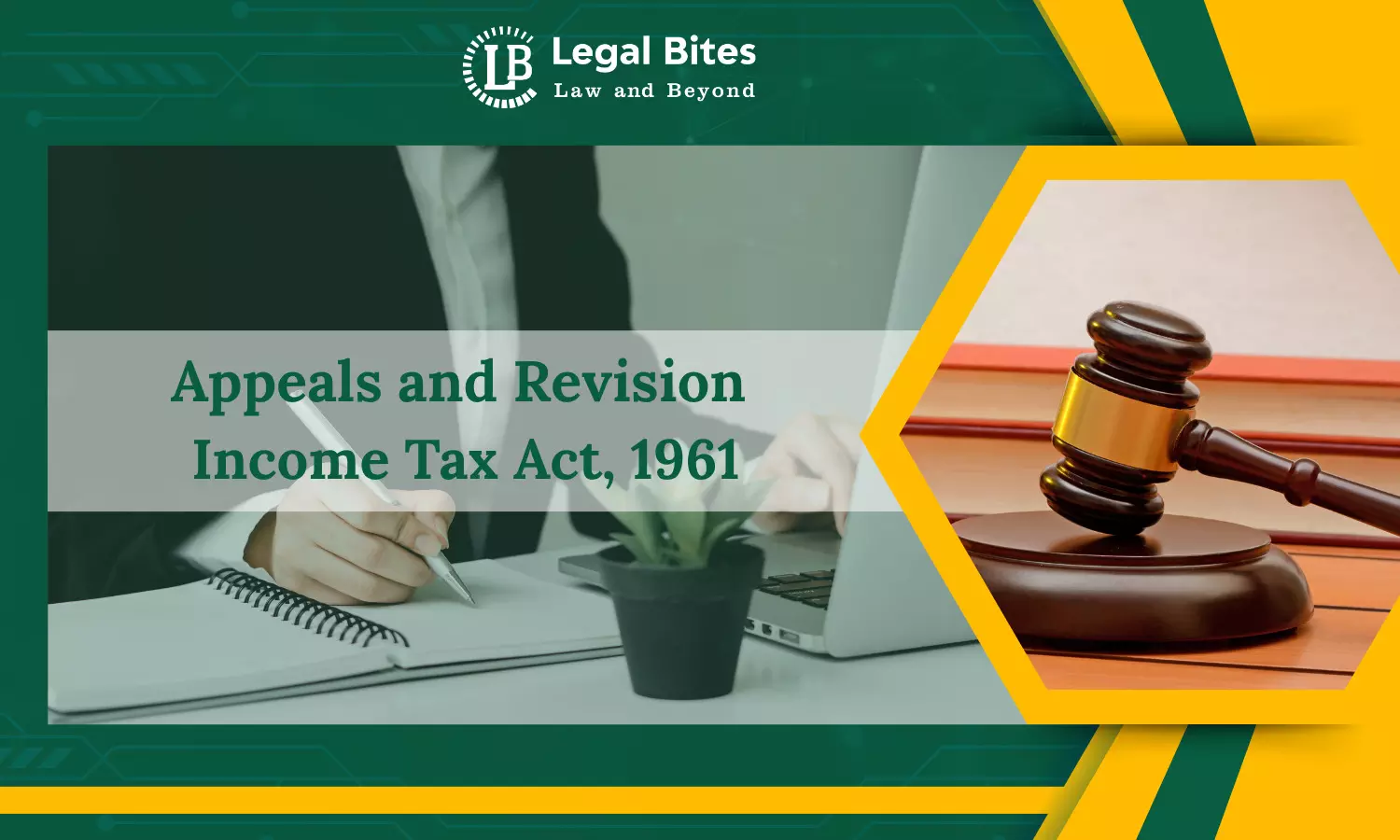Appeals and Revision under the Income Tax Act, 1961
The Income Tax Act, 1961 ensures fair tax administration through a structured appellate and revision system for resolving taxpayer grievances.

The Income Tax Act, 1961 provides for a structured mechanism for addressing grievances of taxpayers against assessment or other orders passed by the Income Tax Authorities. This mechanism ensures that taxpayers are not left remediless and that tax authorities are held accountable. Two important remedies under the Act are appeals and revisions.Appeals can be filed against assessment and penalty orders before the Commissioner (Appeals) under Section 246A, with further recourse to the Income...
The Income Tax Act, 1961 provides for a structured mechanism for addressing grievances of taxpayers against assessment or other orders passed by the Income Tax Authorities. This mechanism ensures that taxpayers are not left remediless and that tax authorities are held accountable. Two important remedies under the Act are appeals and revisions.
Appeals can be filed against assessment and penalty orders before the Commissioner (Appeals) under Section 246A, with further recourse to the Income Tax Appellate Tribunal (ITAT) under Section 253. Judicial review lies with the High Courts and Supreme Court under specified conditions.
In parallel, Sections 263 and 264 empower the Commissioner to revise orders that are either prejudicial to revenue or require relief to the assessee. Recent amendments have clarified the computation of limitation periods where proceedings are stayed by courts. These mechanisms uphold the principles of natural justice and provide a structured remedy for aggrieved taxpayers and the department alike..
This article delves into the legal framework, procedural nuances, and judicial interpretations concerning appeals and revisions under the Income Tax Act, 1961.
Appeals under the Income Tax Act
1. First Appeal – Section 246A
Appealable Orders
Section 246A lists various orders passed by the Assessing Officer (AO) or other authorities that are appealable to the Commissioner of Income Tax (Appeals) [CIT(A)]. These include:
- Order by Joint Commissioner under Section 115VP(3)(ii).
- Order where assessee denies liability to be assessed
- Intimation under Section 143(1)
- Section 154 or 155 – Order that:
Enhances the assessment, or
Reduces a refund, or
Refuses to allow a claim under these sections.
Excludes orders under Section 144BA(12).
Time Limit for Filing
30 days from the date of service of notice of demand or order.
Format and Filing
- Appeals must be filed in Form No. 35.
- Must be verified and signed as per the Income Tax Rules, 1962.
- Filed with the office of Commissioner (Appeals) having jurisdiction.
Should include:
- Grounds of appeal clearly and concisely stated.
- Statement of facts.
- Certified copy of order appealed against.
- Copy of notice of demand (if applicable).
- Statement of additional evidence, if any, with reasons for submission.
Powers of Commissioner (Appeals)
The Commissioner (Appeals) has broad powers under the Act:
- Confirm, reduce, enhance or annul the assessment.
- Call for information, examine witnesses, and admit new evidence if required.
- Remand the case to Assessing Officer for further inquiry.
- Has quasi-judicial powers and must provide an opportunity of hearing before passing an adverse order.
Note: The powers of the Commissioner (Appeals) are governed by Sections 250 to 251 of the Income Tax Act, 1961.
2. Second Appeal – Section 253
An appeal can be filed before the Income Tax Appellate Tribunal (ITAT) against the order of the CIT(A).
Appealable Orders to ITAT:
- Orders passed under Section 250, 271, 271A, etc.
- Orders regarding transfer pricing adjustments
- Orders passed by Principal Commissioner or Commissioner under Section 263 (revision) or 12AA
Time Limit
60 days from the date of receipt of the order.
Procedure and Powers
- Appeals are filed using Form No. 36
- ITAT is the final fact-finding body.
- Binding on lower authorities unless reversed by the High Court or the Supreme Court.
3. Appeal to High Court – Section 260A
An appeal lies to the High Court if there is a substantial question of law arising out of the order of the ITAT.
Essentials:
- Must be filed within 120 days
- Appeal must be admitted by the High Court
Pr. CIT (Central)-3 v. Dharampal Premchand Ltd. (2017):
In this case, the Delhi High Court dismissed the Revenue’s appeals challenging the ITAT's decision that additions under Section 153A/143(3) of the Income Tax Act were unwarranted.
The Court held that no incriminating material was found during the search under Section 132 that pertained to the relevant assessment years (AYs 2005–06 to 2007–08), thus failing the jurisdictional requirement for reopening assessments under Section 153A as per the ruling in CIT v. Kabul Chawla. It reaffirmed that unless such incriminating material exists qua each year, reopening is not valid.
The Revenue’s reliance on Smt. Dayawanti Gupta was rejected, as it involved different facts, and the Court upheld Meeta Gutgutia as consistent with Kabul Chawla. Accordingly, the appeals were dismissed in favour of the assessee.
4. Appeal to the Supreme Court – Section 261
An appeal lies to the Supreme Court from a High Court judgment—on a reference under Section 256 or an appeal related to a Section 254 order—if the High Court certifies the case as fit for appeal and the judgment was delivered before the establishment of the National Tax Tribunal.
Revision under the Income Tax Act
Revision is a remedy available before higher administrative authorities, usually the Commissioner of Income Tax, in cases where an appeal is not filed or is not permissible.
1. Revision by the Commissioner – Section 263
This section empowers the Principal Commissioner or Commissioner to revise any order passed by the AO (Assessing Officer) if it is:
- Erroneous and
- Prejudicial to the interest of the Revenue
Time Limit:
2 years from the end of the financial year in which the order was passed.
Common Grounds:
- Incorrect application of law
- Lack of enquiry
- Understatement of income
In Malabar Industrial Co. Ltd. v. CIT (2000), the Supreme Court upheld the exercise of revisionary powers by the Commissioner under Section 263 of the Income Tax Act, ruling that the assessment order passed by the Income Tax Officer was both erroneous and prejudicial to the interests of the revenue. The Court clarified that for Section 263 to apply, two conditions must be met: the order must be erroneous and it must cause prejudice to revenue. It held that the Assessing Officer’s failure to inquire into or apply his mind to a ₹3.66 lakh receipt—claimed as compensation for agricultural loss—justified the Commissioner’s revision. The Court also ruled that since the amount was unrelated to any agricultural operations, it was taxable as "income from other sources."
2. Revision by the Commissioner on Application – Section 264
A taxpayer may apply for revision of any order (other than an order under Section 263) before the CIT.
Essentials:
- Must be filed within 1 year from the date of communication of the order.
- The Commissioner may suo moto revise an order if it's in the interest of justice.
Recent Developments and Amendments
Faceless Appeals
The Faceless Appeal Scheme, 2020 aims to eliminate interface between taxpayer and appellate authority.
- Automated allocation of appeals
- No physical appearance unless allowed
- Transparency and accountability ensured
Introduced via Notification No. 76/2020, dated 25.09.2020
E-Filing of Appeals – Rule 45 of Income Tax Rules, 1962
- Mandatory e-filing of Form 35 before CIT(A)
- Ensures efficiency and digital traceability
Limitations and Challenges
- Delayed disposal of appeals causes hardship to taxpayers
- Overburdened appellate forums
- Faceless appeals are still evolving, with technical glitches and accessibility concerns
- Complexity of forms and legal language remains a barrier for unrepresented assessees
E-Appeals Scheme
The Central Government, via Notification No. 33/2023 dated 29th May 2023, introduced the e-Appeals Scheme, 2023 under the Income-tax Act, 1961. This scheme enables electronic filing and processing of appeals under Section 246, to be handled by the Joint Commissioner of Income Tax (Appeals). It includes procedures for appeal hearings, delay condonation, evidence submission, and digital issuance of appeal orders.
Appeals will be randomly allocated by the income tax system, and penalties may be levied for non-compliance. The scheme aims to streamline and digitize the appellate process, making it more efficient and transparent.
Finance Act 2025: Amendments to Sections 263 and 264 of the Income-tax Act:
The Explanations to Sections 263 and 264 have been amended to clarify the computation of limitation periods in cases where proceedings are stayed by a court. Instead of merely referring to "any period during which the proceeding is stayed," the revised language now specifies that the excluded period will be from the date of the stay order to the date on which the jurisdictional Principal Commissioner or Commissioner receives the certified copy vacating the stay.
Conclusion
The appeal and revision framework under the Income Tax Act, 1961 serves as a vital tool for tax justice. It ensures checks on arbitrary or erroneous assessments and provides taxpayers with a structured remedy against grievances. As tax laws grow in complexity, the role of appellate forums and revisional authorities will continue to be central in ensuring fairness, legality, and procedural propriety. Going forward, digitisation and reforms such as the Faceless Appeal Scheme are expected to make tax justice more transparent and efficient.
References
[1] Pr. CIT (Central)-3 v. Dharampal Premchand Ltd. 2017(8) TMI 958
[2] Malabar Industrial Co. Ltd. v. CIT AIR 2000 SC 1855
[3] Income Tax Act 1961
[4] Income Tax Rules 1962

Ananya Gupta
Ananya is an alumnus of the prestigious Government Law College, Mumbai, specializing in Corporate Law. A passionate legal scholar, she is deeply involved in research, focusing on corporate governance and regulatory frameworks.
